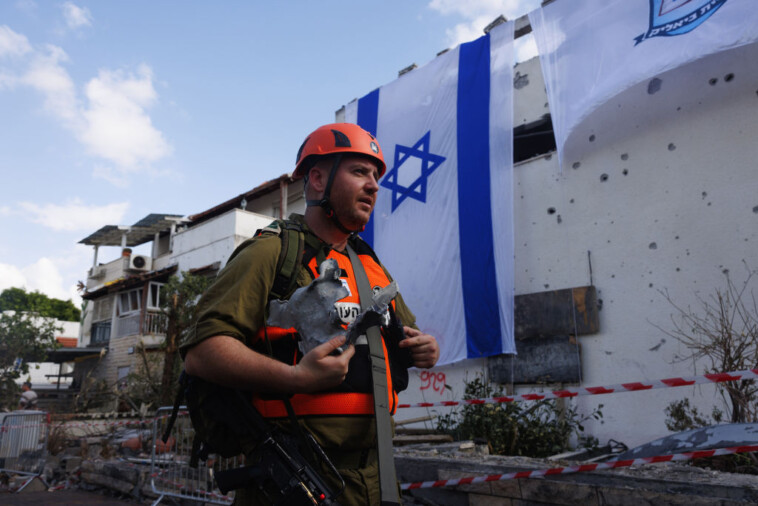Last week the world watched as the terrorist army Hezbollah was hit by an attack that was equal parts debilitating and humiliating. On Tuesday, September 17, the special pagers carried by Hezbollah operatives suddenly exploded. Then, on Wednesday, their walkie talkies literally blew up.
Although Israel has not claimed responsibility for the operation, in the event they did carry out this historically unprecedented strike, it was entirely justified and in full accordance with international law.
It is not surprising that it did not take long for the usual chorus of anti-Israel politicians and pundits — those who only remember International Humanitarian Law (IHL) whenever they think it might hurt the Jewish State — to find some obscure provision, divorced from context, that they might deceptively latch onto and accuse Israel of violating, knowing full well that the uneducated armchair ‘experts’ who blindly follow them would thoughtlessly amplify their claims, muddy the waters of good vs. evil, and somehow make Israel the bad guy again.
This time, the frenzied cries centered around Article 7 of the Amended Protocol II to the 1980 Convention on Certain Conventional Weapons, which prohibits the use of booby-traps in certain circumstances. Pseudo-academics like Kenneth Roth could not wait to tell their breathless adherents that IHL unequivocally “prohibits the use of booby traps” — even though it is obvious that if booby traps are prohibited in certain circumstances, they must be permitted in others.
For the record, this is one of those permitted times, and here, with citations, is why.
First, it is important to establish that communication devices ordered by terrorists, issued to terrorists, for terrorist purposes, do not count as harmless civilian objects. Under Article 52 of the Additional Protocols to Geneva Convention I, the communication devices that a designated foreign terrorist organization issues to its operatives are legitimate military targets, and this should not be controversial. The fact that civilians may also use cell phones does not mean that you cannot target a terrorist call center.
Article 7 of the Amended Protocol II provides certain restrictions as to the use of booby traps and other similar devices. Paragraph 1 lists certain categories of objects — religious objects, children’s toys, etc. — for which it is prohibited to use booby traps in all circumstances. The devices in question do not fall under any of those categories.
Paragraph 2 of Article 7 prohibits using booby traps or other devices in the form of apparently harmless portable objects which are specifically designed and constructed to contain explosive material. As the U.S. Department of Defense Law of War Manual explains:
The prohibition is intended to prevent the production of large quantities of dangerous objects that can be scattered around and are likely to be attractive to civilians, especially children.
It has nothing to do with communications devices procured by terrorists for terrorists, devices that were not specifically designed and constructed to contain explosive material, and were instead modified to detonate once they clearly became military objects.
Paragraph 3 of Article 7 reminds us that even when permissible any such weapon must be placed “in the close vicinity of a military objective.” It is hard to imagine a more surgically precise procedure than the destruction of personal devices that were (literally) held by terrorists.
Am I Racist? Is In Theaters NOW — Get Your Tickets Here!
Analyzing the legality of a military operation also requires factoring in the principles of necessity, distinction, and proportionality. The principle of necessity permits actions necessary to accomplish a legitimate military purpose. In this instance, in a single operation, an entire enemy army was significantly impacted, and not only physically – the attack also exposed the Hezbollah network, in Lebanon but also throughout the Middle East where Hezbollah agents or affiliates were carrying these specific Hezbollah issued pagers. The devastating psychological impact also cannot be discounted; Hezbollah can no longer trust their own equipment, cannot communicate (ironically, they are rumored to have switched to pagers out of concerns Israel was monitoring their comms!), and will have to change many elements of their operations with the potential to make further mistakes that can then be exploited.
The principle of distinction requires combatants to distinguish between civilians and military objectives during armed conflict. Here, the attack specifically targeted combatants, members of the Hezbollah army who had received specific Hezbollah equipment that is usually kept on their person. The law does not require perfect accuracy, which is impossible, and that leads to the principle of proportionality: Would such an attack be expected to cause incidental loss of civilian life, injury to civilians, damage to civilian objects or a combination thereof which would be excessive in relation to the concrete and direct military advantage that is anticipated In this case, not a chance. Recall that Hezbollah has been bombing Israel incessantly for almost a year. In a swift and defensive maneuver — fully legal under Article 51 of the UN Charter — Israel (allegedly) immobilized a large segment of a terrorist organization actively hellbent on the genocidal elimination of the country.
Reports say that a few civilians, including two children, were tragically hurt as well. Innocent civilians getting hurt is absolutely tragic, but not in any way unlawful or Israel’s fault.
The truth is that the entire booby trap framework of analysis is wrong. IF Israel did commit these actions, then it was perhaps the finest and cleanest act of lawful sabotage in military history. As the ICRC explains:
Sabotage is generally the work of individuals or small formations operating in enemy-controlled territory and taking advantage of clandestinity, surprise, and ruses of war. It is generally carried out with great precision and therefore does not usually harm the civilian population. The targets of sabotage must form part of the enemy’s material infrastructure, that is, they must be military objectives. To sum up, sabotage against the enemy is a lawful operation provided the legal rules for the choice of targets and the methods and means employed are respected.
To quote one actual international humanitarian law expert, Eugene Kontorovitch:
Those protesting the attack on Hezbollah cell phones would have been crying over bombs placed on Nazi Germany’s train tracks.
The sad conclusion is this: if you are among those who were silent while Hezbollah committed thousands of undeniable, uncontested, and unprovoked war crimes against innocent Israeli civilians — killing men, women, and children in the process — and yet now find yourself horrified that Israel finally responded in a lawful, targeted manner by neutering (in some cases literally) hundreds of the terrorists who had been indiscriminately attacking them for months — your problem is not with Israel’s actions under international law; it is with Israel’s very existence.
* * *
John Spencer is chair of urban warfare studies at the Modern War Institute (MWI) at West Point and host of the ”Urban Warfare Project Podcast.” He is the co-author of “Understanding Urban Warfare.”
Mark Goldfeder is a law professor and Director of the National Jewish Advocacy Center.
Arsen Ostrovsky is a human rights attorney who serves as CEO of The International Legal Forum and senior fellow at the Misgav Institute for National Security.
The views expressed in this piece are those of the authors and do not necessarily represent those of The Daily Wire.

Continue reading this exclusive article and join the conversation, plus watch free videos on DW+
Already a member?



